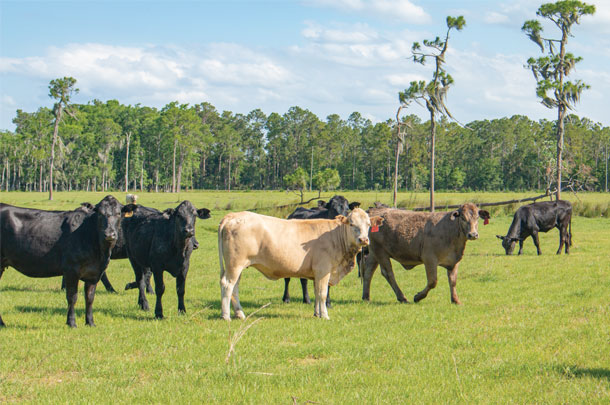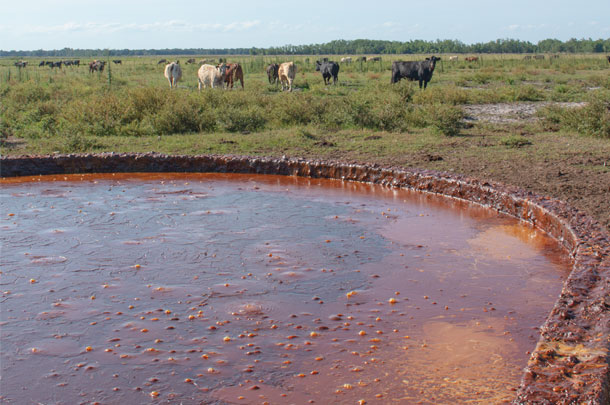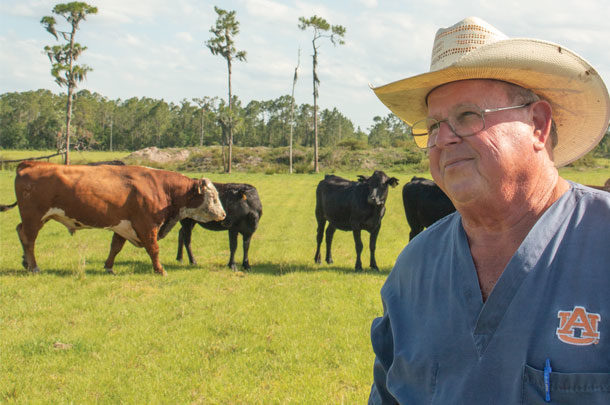In 1976 when Dr. Robert Gukich began his veterinary practice, that’s exactly what he focused on. But today, he says, “I preach fetal programming – proper nutrition throughout the lifetime of the cow – conception to rail. If cow/calf operations are to be sustainable, it’s vitally important to utilize forages. Quality forages are the key to a successful cattle program.”
 In addition to his Lake Wales Large Animal Services practice, Gukich runs a private herd of 1,500 Brahman-cross cows on 6,000 acres of leased land at the G7 Ranch, with another 4,000 of family-owned pasture acres grazing 200 head of family-owned cattle.
In addition to his Lake Wales Large Animal Services practice, Gukich runs a private herd of 1,500 Brahman-cross cows on 6,000 acres of leased land at the G7 Ranch, with another 4,000 of family-owned pasture acres grazing 200 head of family-owned cattle.
During the first trimester of pregnancy (day 50-60), ovarian development begins. At approximately day 80, primordial follicles begin to form, which influences her reproductive life span. So through fetal programming (proper nutrition) you can turn DNA on or off. During certain points of development you can turn on genes that produce the most beef effectively. “Then if I get it right, it pays me to return ownership of those cattle in the feedlot,” he says.
That’s where the nutritional component of forages has the biggest role to play. “Doc has been very successful in managing his bahia pastures for optimal nutritional value,” says Bridget Stice, University of Florida Extension specialist in Polk County. “He has some of the best numbers I’ve seen for bahiagrass.” Leaf samples have tested at 20% to 22% crude protein with 58% to 60% total digestible nutrients (TDN) with low acid detergent fiber (ADF) and neutral detergent fiber (NDF).
“We do that by using sludge – human waste – or ‘biosolids’ is the politically appropriate term. It’s been lime- or heat-treated, so it’s safe to use,” Gukich says. He’s held a contract to spread it for 12 years now, and covers 3,000 acres per year with it.
“You have to have a permit to apply it, and it’s regulated. EPA inspects the sites,” he says. He is also required to post a sign on the farm entrance indicating its use. Gukich has applied 1 to 2 tons per acre, depending on soil samples taken in the spring, with nitrogen levels determining application rates. “We can’t graze cows for 30 days post-application,” he says. The biosolid is essentially in gel form, so it is spread with a truck much like lagoon waste spreads manure from dairies. The pastures are aerated once the biosolid is applied.
Gukich says the sludge has a very low odor level, so he’s had very few complaints. The sludge provides nitrogen, phosphorous and potassium, at essentially no cost to the landowners. “We give them the land to put it on and they provide the non-industrial biosolids,” Gukich says. In a state with nearly 22 million people, it’s a win-win system for everyone, and, Gukich maintains, is an essential factor in the forage quality necessary for fetal programming.
The majority of Gukich’s pastures are Argentine bahiagrass. He says, “It’s not unlike soil, where healthy soil microbes make for healthy plants. So too, the microbes in the rumen need to be able to best utilize the nutrition in the grasses. If the cow isn’t healthy she won’t respond to vaccines, won’t breed back and won’t raise a healthy calf. It’s a cycle, but it’s based in forage nutrition.”
Based in Lake Wales, Florida, a casual observer might assume cattle would graze year round, but Gukich also puts up a small amount of dry hay and haylage – about 1,200 round bales at 1,500 pounds each. While some producers graze cattle year round, Gukich says, “It’s about fetal programming again and not stressing the cow’s rumen but providing her with all she needs to raise that healthy calf.” He feeds hay starting in November usually, about 30 days prior to the cows really needing it. “By the time you’ve noticed they need it, you’re already late and she’s losing body condition,” Gukich says. “The nutrition of grasses starts decreasing in August, so we need to get ahead of her needs.”

With citrus groves weaving throughout Polk County, a byproduct of the citrus industry (residuum) is plentiful. Gukich uses concrete tanks in the pastures at the G7 Ranch to hold the syrupy residuum – a high- energy feed resembling blackstrap molasses – helping to ensure nutritional needs are being met. The residuum has a bitter/sweet taste but is relatively low in crude protein and phosphorus.
Gukich also works in research projects with Warner University, University of Central Florida and commercial companies. One recent project with Alltech includes looking for cattle with high immune response to vaccines. He’d like to develop a chute-side test to determine high responders and says, “If this can be perfected, the rancher would know which calves to retain ownership on when they go to feedlots.” An effective chute-side test could lead to increased number of calves delivered by pregnant cows, increased survival rate of calves from birth to weaning and improved general health of the calf including their response to commercial vaccines, disease occurrence and weight gain.
Another research project that Gukich is just starting with Alltech stems from the mycotoxins problem in grasses. They’re looking at a solution regarding binders and enzymes that benefit healthy rumens to mitigate the mycotoxins issues. “To mitigate mycotoxins, you can burn the grasses and drag pastures to prevent the vegetative mats where they tend to grow, but that’s not always practical – for smoke and air quality problems – and ‘muck fires’ of the organic material are hard to put out,” Gukich says.
Gukich also spends time participating in the Florida Panther Conservation Bank – a 1,930-acre bank in Hendry County that supports recovery of the panther population by restoring, preserving and managing high-quality habitat and protection. As a partner, Gukich receives Panther Habitat credits to offset and compensate landowners for developmental impacts. Part of his duties require maintaining the habitats, suppressing non-native plant species and maintaining passages and buffer zones in perpetuity. Part of the maintenance includes planning controlled burns to take out invasive species, such as Florida pepperbush and melaleuca trees.
Gukich’s professional practice and ranch puts him at the center of some of the largest cattle herds in the country, many of which utilize Gukich’s veterinary services. He was a founding member of Florida Cattle Ranchers LLC, which sponsors a 10-ranch program that began a “Fresh from Florida Beef” program – a marketing program aimed directly at Florida consumers.
Today there are 13,000 head of cattle in the program that are born, raised, feedlot fed and railed in Florida, and “22 million Floridians want ‘local’ beef,” Gukich says. Antibiotics and implants are used as necessary, the cattle are fattened on grains with retained ownership and it’s finding wide appeal in the grocery stores and restaurant trade when it’s packaged as Fresh From Florida Beef. “[Consumers] do care about responsible antibiotic use and implants,” Gukich says. “But also about where it comes from, such as locally grown Fresh from Florida.’”
But it’s not all “sunshine” in Florida’s cattle industry. With rising agricultural farmland values, hurricane and storm damage, wild hogs, alligators and protected vultures that prey on calves, ranchers have plenty of challenges. However, the ranchers are up to the task: “When I started, failure wasn’t a word I even considered,” Gukich says. His Serbian grandparents immigrated “with nothing” but a solid work ethic, which Robert, his wife Doris and their five daughters have tried to honor. “It was a lot of hard work and long hours,” he says, “but I guess I’ve been good enough and believe in God, and I know He’ll continue to care for me like He has through prayer.” ![]()

-
Lynn Jaynes
- Editor
- Progressive Dairy
- Email Lynn Jaynes











